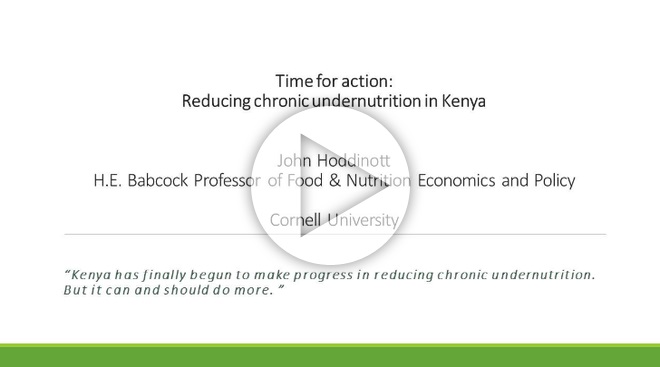Kenya Perspective: Nutrition
Background
Children’s welfare in Kenya has improved significantly since the turn of the century, but there has been very little progress until recently in reducing chronic undernutrition. A good diet is particularly important in the ‘first 1,000 days’, from conception to age two when growth potential is highest, there is a great need for nutrients and children are particularly vulnerable to infections.
Chronic undernutrition – lack of a properly balanced diet, rather than just too few calories – leads to poor physical and intellectual development. Children are short for their age, a condition known as stunting. Growth lost in these early days is never fully recovered. Children do less well at school and earn less through their adult lives; on average, a 1% loss in height means a 2.4% reduction in wages.
For under-fives, stunting reaches its peak in children aged 18-23 months, and the rate has fortunately now dropped from 45% to 35%. But rates have fallen faster in rich households than in poor ones, and also vary across the country: the overall stunting rate for under-fives is 25%, but it is 29.8% in Rift Valley and only 17.2% in Nairobi. Despite the improvements, there are still an estimated 1.8 million Kenyan children who are chronically undernourished.
A range of direct nutrition interventions can make a big difference. These include improving the health and nutrition of mothers, community-based nutritional programmes and provision of dietary supplements. The cost is significant, at about $102 per child in Kenya – largely for fortified supplementary foods – but the benefits are far greater.
This package raises incomes by 11.3% on average. For a child who receives the interventions over the first 1,000 days, who starts work aged 21 and works till he is 50, the current value of his additional earnings (discounted at a conservative 5% a year) is $2,342. In other words, a shilling spent on the nutritional package today generates 23 shillings of future income gains. The gains would be greater if people work for longer. Even if they work only to age 35, every shilling spent on better infant nutrition generates 18 shillings in future earnings.
The actual benefits are actually greater than this, because the nutritional package would also reduce the deaths of under-fives by 15%. However, by themselves, these interventions would not eliminate stunting and need to be complemented by specific actions in the areas of social protection, agriculture and gender.
Kenya has a long history of providing social protection. The Hunger Safety Net programme has improved food security, for example, but has not reduced chronic undernutrition. Closer coordination between people working on social protection and nutrition is a promising way to make a difference.
Although Kenya has a thriving agricultural sector and can feed about 90% of its population from domestic production, still about one in three Kenyans are food insecure, particularly in the more arid North East and parts of northern Rift Valley province. Young children also need a wide range of foods, including animal proteins and vitamin-rich vegetables. Less than half of those aged 6-23 months receive an acceptable diet, and the situation is not much better in wealthier households. The farming sector can help by increasing yields and growing a greater range of crops.
Improving the status of women, particularly by improving education, can also help reduce undernutrition in their children. In Kenya, 34% of children whose mothers did not complete primary school are stunted, but this level is halved for mothers who have some secondary schooling.
Kenya is finally making progress in reducing chronic undernutrition. It is right to do more, not just because people’s lives are improved but because it also makes economic sense.

